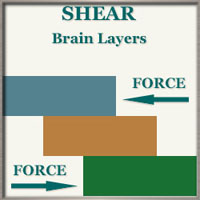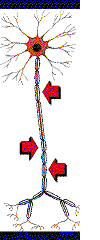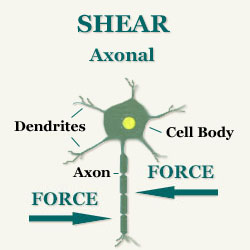Diffuse Axonal Injury
The brain contains many different layers of tissue, each which has a different density. When the brain experiences rapid acceleration/deceleration forces, the different layers are accelerated/decelerated at different speeds. This is especially true when the acceleration is rotational. This will cause a shear force injury or sometimes called diffuse axonal injury.

The most obvious significant difference in the density of the brain tissue is between the cerebral cortex – the “gray matter” – and the subcortical areas -the “white matter”. The axonal part of the neuron may stretch from the gray matter into thru the white matter and into the brain stem, the spinal cord and then out to distant areas of the nervous system.
The axons are the long connective portions of the neurons, which cross the brain’s different layers. When axons are torn or stretched from the layers moving at different speeds, this is called shearing and results in axonal injury, often referred to as Diffuse Axonal Injury. In most cases though, it is more proper to think of this as multi-focal than truly diffuse, as the axonal injury is concentrated in the areas of the brain where the gray and white matter join.
For more information regarding Axons Click Here. This page will give you a more in depth definition and explanation of the axon and its part on how the brain works. It will also explain that once the axon is damaged it can effect brain function which is caused by the brain injury.

Shear Damage Is Microscopic
Unlike what occurs with an most impact injuries, shear injury occurs at the cellular level, as a result of damage to the neuron, particularly the axonal part of the neuron. A diffuse axonal injury may occur.


